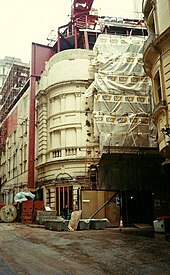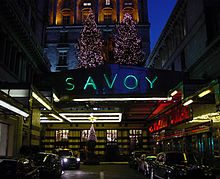Savoy Theater
| Savoy Theater | |
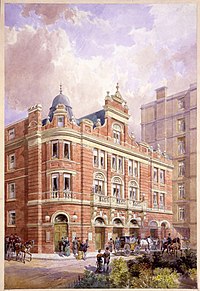
|
|
| location | |
| Address: | Savoy Court WC2R 0ET |
| City: | London |
| Coordinates: | 51 ° 30 '36 " N , 0 ° 7' 15" W |
| Architecture and history | |
| Opened: | 1881 |
| Spectator: | 1,150 seats |
| Architect: | Charles J. Phipps |
| Internet presence: | |
| Website: | https://www.thesavoytheatre.com/ |
| Owner: Ambassador Theater Group | |
The Savoy Theater is a West End theater on Street Strand in the City of Westminster London , England . The theater was commissioned by impresario Richard D'Oyly Carte and opened on October 10, 1881. It was built on the site of the old Savoy Palace by the British theater architect Charles J. Phipps . The Savoy Theater was also the first public building in the world to be fully electrically lit.
Initially it was intended as a venue for a series of comic operas by Gilbert and Sullivan , which was very popular at the time . This type of opera was sometimes only called "Savoy operas". For many years the Savoy Theater became the home of the D'Oyly Carte Opera Company , which was run by the Carte family for a century. Richard's son Rupert D'Oyly Carte renovated and modernized the theater in 1929.
In addition to The Mikado and other famous world premieres by Gilbert and Sullivan, the house also showed premieres, such as the first official performance in England of Oscar Wilde's drama Salome in 1931 (after it was previously banned in its time as blasphemous and also sexually suggestive Play in the country), as well as Noël Coward 's comedy Blithe Spirit (1941).
Building history
Carte had his idea to build the Savoy Theater back in the 1870s. His wish was to make the operas of Gilbert and Sullivan, which he had already successfully brought to other stages, accessible to an even wider audience. For this he took the dilapidated site of the former Savoy Palace (and a later hospital at this point) into account.
Before Carte went on to purchase the land, he obtained an assurance from the city's official authorities that a new road would be built on the south side of the area. In return, the city demanded that Carte should contribute half of the road construction costs. Carte has now purchased the property for £ 11,000 and also fulfilled its financial stake in the road construction in March. However, this was a long time coming. Carte said in the Times that he was caught in the mesh of bureaucracy. Finally he received a firm commitment for June 1880. Meanwhile, increased architect Emden its construction cost estimate initially estimated 11,000 pounds to 18,000 pounds (today's purchasing power would correspond to about 1.8 million euros). He then dismissed the architect. However, the latter charged him his fee of £ 1,790 and £ 3,000 cancellation fee due to the early termination of the contract. Carte now hired Charles. J. Phipps to build his theater. The executing company was called Patman and Fotheringham . The work progressed rapidly and was on schedule. Nevertheless, the opening date had to be postponed several times because work on the electrical lighting, which was considered innovative at the time, was ongoing. Finally, the Savoy was able to open on October 10, 1881.
Initially, Carte wanted to name the theater “Beaufort Theater” because there was a “Beaufort settlement” in the theater area, but he later wrote in an open letter to The Daily Telegraph, “On the Savoy Manor there was formerly a theater have used the ancient name as an appropriate title for the present one. " (The Savoy Mansion used to be a theater. I use the old name as an appropriate title for the present day) The exterior of the building was made of brick and Portland stone. The interior design by Collinson and Locke was based on the Italian Renaissance . The predominant colors are white, pale yellow and gold, complemented by a curtain of gold satin, red boxes and dark blue chairs. There were none of the angels, images of gods or mythical creatures that were common in the decoration of the competitive theaters. Carte didn't want anything that might seem too bright or gaudy to its middle-class target audience.
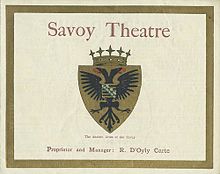
On the opening evening, Phipps received several “ curtains ” along with Gilbert and Sullivan and Carte . The Times commented, “You have a perfect view of the stage from every seat in the house.” There were exits on all four sides of the theater and fireproof materials were used to ensure maximum safety. There were three ranks in four levels. The total capacity was 1,292 seats. The proscenium arch was over nine meters high and just as wide. The stage with the proscenium was over 8 meters deep. The original theater had its main entrance on the Thames Embankment . The lot on which it was built is steep and extends from the beach to the escarpment along old Beaufort Street. After Carte had built the Savoy Hotel in 1889, the theater entrance was relocated to its current location in the hotel's inner courtyard, off the banks of the Thames.
In its time, the Savoy Theater was the best that state-of-the-art technology had to offer, and also the first public building in the world that could be fully electrically illuminated. Joseph Wilson Swan , the inventor of the incandescent lamp , equipped the theater with 1,200 incandescent lamps in 1881. The lights were powered by a 120 HP (89 kW) generator that was set up away from the theater.
Carte explained that the reason why he preferred electric light for his theater was the air pollution and heat of the previously common gas lamps and none of this was the case with incandescent lamps. For safety reasons, the lighting was installed redundantly with gas, but this was only rarely used. However, the power generator that was first used turned out to be too small to illuminate the entire theater and so only the front of the house was illuminated electrically and the stage was lit conventionally with gas until the end of 1881. The newspaper The Times was, the theater is ideal for its purpose, its acoustic quality is excellent and all reasonable demands for comfort and taste might be fulfilled. Carte and his manager George Edwardes, who later became the famous director of the Gaiety Theater in London, introduced various innovations, including numbered seats, free programs, an entry system in front of the entrances to the cheap areas (inspired by an American idea) and free ones Sanitary areas. The quality of the drinks served was also high. What was consumed daily in the theater corresponded to around half of the possible income from ticket sales.
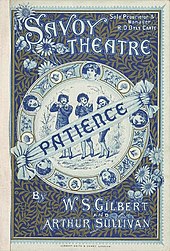
The opening piece was Gilbert and Sullivan's Patience or Bunthorne's Bride , which was shown at the smaller Opera Comique (London) since April 1881 . The last eight of Gilbert and Sullivan's comic operas then had their respective premieres at the Savoy. These include: Iolanthe (1882), Princess Ida (1884), The Mikado (1885), Ruddigore (1887), The Yeomen of the Guard (1888) The Gondoliers (1889), Utopia, Limited (1893) and The Grand Duke ( 1896). The term Savoy opera became a generic term for all of her works. When the collaboration between Gilbert and Sullivan ended in 1898, Carte and later his bereaved wife Helen (with their theater director William Greet (from 1901 to 1903)) brought other comic operas to the stage, such as those by Arthur Sullivan , Ivan Caryll, Sydney Grundy, Basil Hood and Edward German . The Savoy operas of the 1890s, however, were less successful than those of Gilbert and Sullivan before that. After Cartes' production The Chieftain , which ended in March 1895 and was considered a failure by the author Sullivan's standards, the Savoy brought the Carl Rosa Opera Company onto the stage for a few weeks and then closed the theater until the end of the year. Sullivan died in 1900 and Richard D'Oyly Carte a year later.
The Savoy Theater was run by his widow, together with the manager William Greet, for two years and then, from 1903 under new management (John Leigh and Edward Laurillard), it continued in February 1904. The musical The Love Birds was the opening performance and ran until December 1906. The D'Oyly Carte Opera Company soon returned to the Savoy and the baritone singer Charles H. Workman took over the management of the theater. He produced a. a. 1909 William Schwenck Gilbert's opera Fallen Fairies (music by Edward German ), which came to 51 performances with only moderate success. He then produced Two Merry Monarchs and Orfeo ed Euridice (1910) with Marie Brema and Viola Tree in the lead roles. Thereafter, the D'Oyly Carte Opera Company withdrew from the Savoy until 1929, toured Great Britain and also played on other London stages. George Augustus Richardson managed the theater from November 1911 to February 1915. The Mikado's record as the longest-running play on the Savoy was set in 1920 by the vaudeville production Paddy the Next Best Thing (book: Gertrude Page; leading role: Peggy O'Neil ) broken with 867 performances.
Directed by Rupert D'Oyly Carte
In 1915, Richard D'Oyly Cartes son Rupert took over the management of the theater. After his military service in the Navy during the First World War, Carte decided to bring the productions of the D'Oyly Carte Opera Company back to the London stages in a polished version. He designed a compilation of modern revised Gilbert and Sullivan productions and first brought them to the Shaftesbury Theater in the 1919 season. JB Fagan's adaptation of Treasure Island premiered at the Savoy Theater in December 1922. It was so successful that it was on the Christmas repertoire every year until the outbreak of World War II.

On June 3, 1929, Carte closed the Savoy Theater to completely redesign the interior of the theater. Here the architect Frank A. Tugwell was responsible together with the interior designer Basil Ionides . The ceiling was modeled on a sky in April, the walls decorated with translucent gold glaze on silver paint, the parquet seats designed and upholstered in different colors; the colors of the curtains corresponded with the color of the seats. Ionides remarked that he had modeled the choice of colors on a bed of zinnias in Hyde Park . The entire floor was renewed. The old changing rooms and the bar at the back of the theater were moved to the side and the number of boxes was reduced from 18 to just one. The new auditorium had two tiers on three levels: parquet, lower balcony (“dress circle”) and upper balcony. The audience capacity had been reduced from the original 1,292 to 986 by 1912. The newly renovated theater almost completely restored the original capacity of 1,200 seats. The new stage was now 8.93 meters wide and nine meters deep.
The theater opened on October 21, 1929 with a new Charles Rickett production of The Gondoliers , conducted by Malcolm Sargent . In the only remaining box sat Lady Gilbert, the widow of the late librettist. The Savoy Theater had seasons of Gilbert and Sullivan's works in 1929-30, 1932-33, 1951, 1954, 1961-62, 1975, 2000, 2001, 2002 and 2003. Other famous events included the premieres of Noël Cowards Blithe Spirit (1941, which was performed 1,997 times in a row. This also set a new record for non-musical theater), Robert Morley in The Man Who Came to Dinner and various comedies by William Douglas-Home with stars such as Ralph Richardson , Peggy Ashcroft and John Mills . The first official performance in England of the long ostracized scandalous play by Oscar Wilde 's Salome took place in 1931 at the Savoy Theater.
After Rupert D'Oyly Carte passed away in 1948, his daughter Bridget D'Oyly Carte took over the business of the D'Oyly Carte Opera Company. She later became head of the Savoy Hotel Group , to which the theater also belonged. The theater was presumably in the hands of Hugh Wontner, chairman of the Savoy Hotel Group, in 1948. In 1973 the theater was included in the Grade II classification of the Statutory List of Buildings of Special Architectural or Historic Interest . The D'Oyly Carte Opera Company ended its existence in 1982 and Dame Bridget died three years later. Since she had no children, the line of D'Oyly Cartes ended with her. Wontner held the chairmanship of the theater until his death in 1992.
The 1990 fire
During a renovation in February 1990, the building burned down completely. Only the stage and the backstage areas were spared.
Course of events
In the early morning hours of February 12, 1990 at 1:43 a.m., the automatic sprinkler system above the stage was activated . This also triggered the fire alarm. The first fire brigade units arrived at 1:49 a.m. and found a major fire that had already broken out completely. After two hours it was brought under control. Ten water hoses were used. Four firefighters were injured. At 2:09 p.m., the last unit left the scene of the fire. Due to the fire doors and the iron curtain , only the auditorium was affected by the destruction. Neither fire alarms nor fire fighting equipment were installed in this. The air in the large room together with the slowly smoldering horsehair cushion of the seats made it possible for the fire to remain undetected for a long time. Only when the iron curtain gave way at one point did the stage sprinklers go off. However, the fire was raging in full force by then. The whole room was badly destroyed and the roof collapsed in places. Most of Basil Ionides' magnificent decorative elements were lost. The neighboring Savoy Hotel was evacuated on time and suffered no damage. The total damage amounted to 10 million pounds (over 11 million euros) plus the loss from the canceled productions. The fire probably broke out behind the row of parquet seats, but the exact cause could never be clarified in the end.
reconstruction
An application to rebuild the theater as a new building failed due to objections from the insurers and the preservationists of the English Heritage . It was decided to restore the building to the state it was in in 1929. The lavish work of Tugwell and Ionidess has been painstakingly restored. On July 19, 1993, the theater reopened with a royal gala and a specially commissioned ballet production Savoy Suite by choreographer Wayne Sleep with music by Sullivan. This was followed by the World Chess Championship with the eventual winner Garry Kasparov .
Today's theater seats 1,158 spectators. An additional floor was also added during the reconstruction. It houses the hotel's fitness facilities and a swimming pool above the stage.
The modern Savoy Theater
In 1993, when it opened, the Savoy Theater started a successful series of 477 performances with Noël Coward's Relative Values (German: exchange of love , comedy in 3 acts from 1951). Tom Stoppards Travesties with Antony Sher in the lead role followed and in 1994 the musical She Loves Me started . This was followed by Terry Johnson's Dead Funny , Alan Ayckbourn's Communicating Doors (which was adapted for the theater in 1996), John B. Priestley's When We Are Married with Dawn French , Alison Steadman and Leo McKern , and Ben Travers' Plunder with Griff Rhys Jones and Kevin McNally . The Savoy Group transferred the leadership to a group led by Stephen Waley-Cohen. The following productions were Simon Callow in the one-man show The Importance of Being Oscar , Pet Shop Boys in concert, Ian Richardson in Pineros The Magistrate (from 1885), Edward Fox in A Letter of Resignation , The Royal Shakespeare Company with hers Production of Richard III with Robert Lindsay and Coward's Hay Fever with Geraldine McEwan in 1999.
At the turn of the millennium, the D'Oyly Carte Opera Company came together again and produced the operetta H.MS Pinafore in the Savoy . Donald Sutherland played in Enigmatic Variations , followed by a second season of the D'Oyly Carte Company with the comic opera The Pirates of Penzance . The jukebox musical Return to the Forbidden Planet followed in 2002 ; then the D'Oyly Carte Company put the pieces Iolanthe , The Yeomen of the Guard and Der Mikado on the program again, followed by Yasmina Reza's Life x 3 . In 2003 the company repeated HMS Pinafore , followed by Bea Arthur at The Savoy , John Steinbecks Von Mäusen und Menschen , Peter Pan and Pirates . Other pieces the following year included The Marriage of Figaro and The Barber of Seville , performed by the Savoy Opera Company. Lorna Luft appeared in songs My Mother Taught Me and in the new salsa musical Murderous Instincts . Coward's Blithe Spirit was re-performed in 2004-05.
The Savoy Hotel Group was sold together with the theater in 2004 through the agents of Quinlan Private . A year later the theater was sold to the Ambassador Theater Group (ATG) and the hotel to the Tulbart Group. The latter then sold the hotel to Prince al-Walid ibn Talal . Since then, productions have been limited to reviving old pieces and taking over modern musicals, including 2006 The Rat Pack: Live from Las Vegas and a musical version of Porgy and Bess (directed by Trevor Nunn ), 2007-08 Fiddler on the Roof , 2008-09 Carousel , 2010–12 Naturally Blonde , 2013–14 Let It Be , 2014–15 Dirty Rotten Scoundrels ,, 2015 Gypsy , 2016 Funny Girl , 2016–19 Dreamgirls , and 2019 9 to 5: The Musical .
Individual evidence
- ^ Carte, Richard D'Oyly. "Building Difficulties," The Times , May 22, 1880, p. 6
- ↑ Inflation: the value of the pound 1750–2011 RESEARCH PAPER 12/31 of May 29, 2012, published by: House of Commons , online as PDF (1.9 kB): [1]
- ↑ a b c d "100 Electrifying Years", The Savoyard , Issue XX No. 2, D'Oyly Carte Opera Trust, September 1981, pages 4-6
- ↑ Rollins and Witts, p. 8
- ↑ a b c d e f Howard, p. 214
- ↑ a b Oost, p. 59
- ↑ a b c d e "The Savoy Theater", The Times , October 3, 1881
- ↑ There were 18 private boxes with 72 seats, 150 seats parquet , 250 pitches , 160 balconies, 160 "circles", and 500 on the "amphitheater" and gallery. "The Savoy Theater," The Times , October 3, 1881
- ↑ Who's Who in the Theater , 1912, p. 297. Chapple, p. 11 and Howard, p. 214. There the dimensions are given as 18 m wide and 16 m deep, but here the side wings and the backdrop rooms are included in the background included.
- ^ Goodman, p. 27
- ↑ a b Burgess, Michael. "Richard D'Oyly Carte", The Savoyard , January 1975, pages 7-11
- ↑ Henderson, Tony. "Tale of tragedy behind the triumphs of Joseph Swan" , The Journal , September 28th 2011, accessed on June 9, 2019
- ↑ Baily, p. 215
- ^ "The Savoy Theater," The Times , October 11, 1881
- ↑ a b c d e Clemence Bettany: D'Oyly Carte Centenary 1875–1975. D'Oyly Carte Opera Trust, London 1975 (no page naming possible as there are no page numbers in the book)
- ^ Wilson and Lloyd, p. 29
- ↑ Dark and Gray, p. 85
- ↑ Rollins and Witts, pp. 16-19
- ^ Wilson and Lloyd, p. 52
- ↑ Rollins and Witts, p. 22
- ^ Wearing, Issue 1, p. 24
- ^ Rollins and Witts, pp. 22-154.
- ↑ Gaye, p. 1536
- ^ "London Life - a commentary" The West Australian January 31, 1923, p. 10
- ↑ Chapman, p. 32
- ↑ Who's Who in the Theater , 1912, p. 297: The seating plan shows only 8 boxes instead of the original 18 and a reduced number of seats in dress (156) and upper circle (127).
- ↑ "Reopening of the Savoy", The Times , October 21, 1929th
- ↑ Ellis, Samantha. "Salomé, Savoy Theater, October 1931" , March 26, 2003
- ^ The Times , Hugh Wontner's obituary, November 27, 1992
- ↑ Heritage Under Fire PDF, 3.5 MB, p. 90 (English)
- ↑ Young, John. "Royal gala marks rebirth of D'Oyly Carte's theater". The Times , Jul 20, 1993, p. 6
- ↑ Kevin Chapple obituary, The Stage , January 8, 2008, accessed June 11, 2019
- ^ Church, Michael. "An object all sublime" , The Observer , May 30, 1993, p 55
- ↑ Keene, Raymond and Ian Murray. "Kasparov clinches world title after Short accepts draw", The Times , October 20, 1993, p. 10
- ↑ Gaye, p. 1537
- ↑ a b Information on the Ambassador Theater Group website
- ↑ Walsh, Dominic. "Savoy Group changes name after deal," The Times , Jan 25, 2005
- ↑ Bawden, Tom. "Curtain rises on new Savoy Theater owner," The Times , October 13, 2005; Wolf, Tom. "Savoy Theater (sic) sold to Ambassador" , October 13, 2005
- ^ Fiddler on the Roof , This is Theater
- ^ "Carousel Posts Closing Notices at Savoy, Jun 20" . WhatsOnStage, June 9, 2009.
- ^ " Legally Blonde Ends West End Run Tonight," BroadwayWorld.com, April 7, 2012
- ↑ O'Boyle, Claire. "Let It Be top of your list" , The Sunday Mirror , February 24, 2013
- ↑ Maxwell, Dominic. "Comic vitality and saucy staging make up for lack of oomph," The Times , April 3, 2014
- ^ "Gypsy's five star return to London's West End," BBC News, April 16, 2015
- ^ "Victoria Wood remembered at Funny Girl opening," BBC News, April 21, 2016
- ^ "Lion King helped Dreamgirls transfer to West End," BBC News, December 15, 2016
- ^ "Dolly Parton's 9 to 5 The Musical is coming to the West End" , Official London Theater, September 18, 2018
literature
- Michael Ainger: Gilbert and Sullivan - A Dual Biography . Oxford University Press, Oxford 2002, ISBN 978-0-19-514769-8 .
- Reginald Allen: The First Night Gilbert and Sullivan , centennial. Edition, Chappell, London 1975, ISBN 978-0-903443-10-4 .
- Leslie Baily: The Gilbert and Sullivan Book , fourth. Edition, Cassell, London 1956, OCLC 21934871 .
- Clemence Bettany: D'Oyly Carte Centenary 1875-1975 . D'Oyly Carte Opera Trust, London 1975, OCLC 3511414 .
- Don Chapman: Oxford Playhouse: High and Low Drama in a University City . University of Hertfordshire Press, Hatfield 2009, ISBN 978-1-902806-86-0 .
- Kevin Chapple: Reflected Light: The Story of the Savoy Theater . Dewynters, London 1993, OCLC 80573775 .
- Sidney Dark : WS Gilbert: His Life and Letters . Methuen, London 1923, OCLC 3389751 .
- John Earl: Guide to British Theaters 1750–1950 . Theaters Trust, London 2000, ISBN 978-0-7136-5688-6 .
- Freda Gaye: Who's Who in the Theater , fourteenth. Edition, Sir Isaac Pitman and Sons, London 1967, OCLC 5997224 .
- Andrew Goodman: Gilbert and Sullivan's London . Spellmount (UK) and Hippocrene (US), Tunbridge Wells and New York 1988, ISBN 978-0-87052-441-7 .
- Diana Howard: London Theaters and Music Halls 1850–1950 . Library Association and Gresham Press, Old Woking 1970, ISBN 978-0-85365-471-1 .
- Regina Oost: Gilbert and Sullivan: Class and the Savoy Tradition, 1875-1896 . Ashgate, Farnham, UK and Burlington, US 2009, ISBN 978-0-7546-6412-3 .
- John Parker: Who's Who in the Theater , first. Edition, Sir Isaac Pitman and Sons, London 1912, OCLC 320573141 .
- Cyril Rollins: The D'Oyly Carte Opera Company in Gilbert and Sullivan Operas: A Record of Productions, 1875-1961 . Michael Joseph, London 1962, OCLC 504581419 .
- JP Wearing: The London Stage, 1910-1919: A Calendar of Players and Plays . Scarecrow Press, New Jersey, ISBN 978-0-8108-1596-4 .
- Robin Wilson: Gilbert & Sullivan - The D'Oyly Carte Years . Weidenfeld and Nicolson, London York 1984, ISBN 978-0-297-78505-7 .
Web links
- Savoy Theater
- Savoy Theater Website of the Ambassador Theater Group
- Description of the theater in The Times, October 3, 1881
- Description of the opening event in The Times on October 11, 1881

